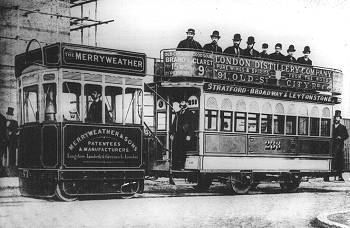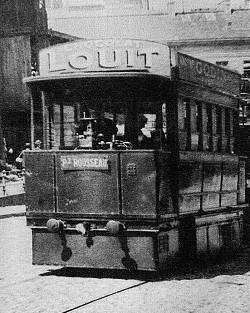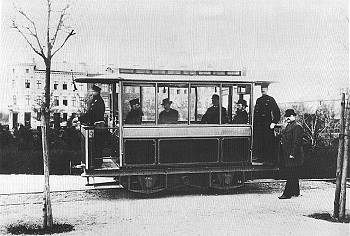 An artist's impression of what G.F.Train's first London tramway of 1861 would have looked like. It is in Bayswater Road showing Marble Arch.
An artist's impression of what G.F.Train's first London tramway of 1861 would have looked like. It is in Bayswater Road showing Marble Arch.
|
Tramway Origins and Pioneers
By John Prentice |
The word "tram" is probably of Scandinavian origin, meaning beam and came to be applied to the tracks of wood beams laid to form a "tram way" in mines, on which tubs of ore could be transported. They date from the middle ages.
The first tramway in the true sense was created by a young Irishman called John Stevenson, who had a coach-building business in New York. Realising that the condition of the streets was too poor for buses, he formed a company to lay "street railway" tracks in the road, on which horse drawn vehicles could run. On the 26th November 1832 the New York & Harlem Railroad was formally opened. Twelve days later a tram built at Stevenson's works and named John Mason after the president of the company, started the public service. The idea of street railways grew in the US and further new lines followed.
The first trams in Europe were in Paris, France. Alphonse Loubat had seen the Stevenson cars in the States and was granted permission to build a line from Place de la Concorde to Pont de Sèvres and to the Village of Boulogne. It began a trial operation on 21st November 1853 as far as Passy, being extended and officially opened to Sèvres by October 1854. The two original cars were built by Stevenson in the States and the trams became known as the Chemin de fer Americain. To enable his vehicles to continue from Cours la Reine to the Louvre, they were provided with a device to change the wheels from flanged ones to flat tyres, so that the car could proceed as a bus over the cobbled streets.
In England William Joseph Curtis, having inspected the Paris line in 1855, obtained permission to operate a similar tram-bus over the tracks of the railways of the Liverpool docks, which commenced in March 1859, making this the first British tramway. (see Horse Trams on Rail and Road)
 An artist's impression of what G.F.Train's first London tramway of 1861 would have looked like. It is in Bayswater Road showing Marble Arch.
An artist's impression of what G.F.Train's first London tramway of 1861 would have looked like. It is in Bayswater Road showing Marble Arch.
The man often credited with bringing trams to Britain, despite them already being there, was the American George Francis Train. He did in fact lay the first true street tracks, these being in Birkenhead and which opened on 30th August 1860. This he followed with three lines in London, the Bayswater Road line opening on 23rd March 1861, one in Victoria Street on 15th April 1861 and then a third from Westminster Bridge to Kennington on 15th August 1861. The London lines largely failed due to serious opposition to the rails, which were of a "step" type, and which damaged the wheels of private carriages. The idea of trams was however sound and other more successful horse tramways were opened elsewhere using grooved rails.
To build a tramway in the UK, it was necessary to pass an Act of Parliament containing all the rules and regulations each time, all of which had to be discussed and voted on, which was expensive and time consuming. To make this easier the 1870 Tramways Act was passed which set out all the basic conditions. Each tramway then only had to get a simple act for their tramway covering local conditions, much quicker and cheaper. Indeed this caused a rush of new horse tramways to be built in the 1880s.
The 1870 Act had a few problems though. One was that a local council could veto the building of a tramway. Some did and this is why trams never ran in the square mile of the centre of London (the "City"). Another was that the tramway had to maintain at their own cost the roadway surface between the tracks and 18 inches to either side. Fine in horse car days as this was the part of road that the horses wore out, but by electric days it meant that the tramways paid for the road for its competition (buses) to run on.
But the real snag of the 1870 Act was this fact that any local council had the option to compulsorily purchase (normally at scrap value) the tramway 21 years after it was built, and every 7 years thereafter, and then run it themselves. This meant that the tramway companies were extremely reluctant to modernised their systems.
 An experimental Merryweather steam locomotive pulling horse tram 238 of London's North Metropolitan Tramways in 1877. Trials took place between Stratford and Leytonstone.
An experimental Merryweather steam locomotive pulling horse tram 238 of London's North Metropolitan Tramways in 1877. Trials took place between Stratford and Leytonstone.
But mechanical traction did arrive. Steam was popular. John Grantham demonstrated a self contained steam tram in London as early as 1873 (from 1876 to run in regular service at Wantage, see photograph), although a separate tram engine pulling a horse tram-like car was more common. In the same year, cable traction was started in San Francisco by Andrew S.Hallidie. In a number of cities in France, Louis Mékarski ran compressed air tramway routes, Nantes the first from 1879, many routes in Paris from 1887 (see Compressed Air Trams). Petrol-electric, gas, batteries and other methods were tried, but it was electric traction that won the day.
 Louis Mékarski experimented with compressed air trams from 1875, and operated a public service in Nantes from 1879. This is one of the original trams, which continued to run until 1917. One has been preserved.
Louis Mékarski experimented with compressed air trams from 1875, and operated a public service in Nantes from 1879. This is one of the original trams, which continued to run until 1917. One has been preserved.
On 31st May 1879, Dr. Werner von Siemens demonstrated a small passenger carrying vehicle at the Berlin Trades Exhibition. It was electrically driven from a third rail supply and carried over 80,000 passengers in a few months. The Siemens and Halske company went on to open on 12th May 1881 the first true electric tramway, from the Anhalt railway station in Lichterfelde, near Berlin, to the Cadet School 1.5 miles away. It was metre gauge and used two rail current supply at 180 volts.
 Siemens and Halske opened the world's first true electric tramway in 1881 at Lichterfelde, near Berlin.
Siemens and Halske opened the world's first true electric tramway in 1881 at Lichterfelde, near Berlin.
In the UK, Magnus Volk opened the first tram-like electric railway on 3rd August 1883 at Brighton, again using two rail but later three rail electric pickup. This line is still in operation. The Giant's Causeway tramway in Ulster was built and tested a little earlier in January 1883 but this line did not enter public service until 18th September of that year. On September 29th 1885 the first true street electric tramway opened in Blackpool, using a conduit current collection devised by Michael Holroyd Smith. A full table of the dates of the opening of British electric tram systems is given on the British Systems List.
Overhead current collection was clearly the best form for trams, but at first systems were tried with shuttles running in a slotted tube and four wheel "trolleys" running on the top of twin wires. The trolley pole and wheel method of current collection was perfected in 1887 by Frank J. Sprague in the US for the line at Richmond, Virginia (see also Charles J. Van Depoele) and in the UK a trolley pole overhead system was opened on 29th October 1891 at Roundhay Park, Leeds. From that time onwards thousands of electric tramways developed world-wide.